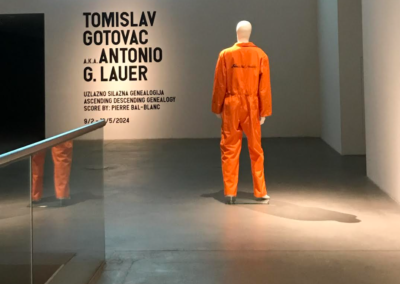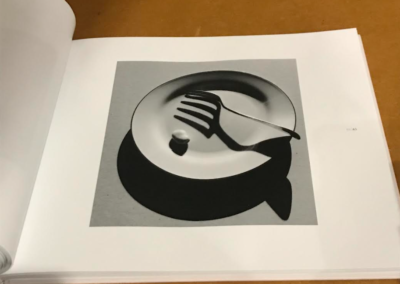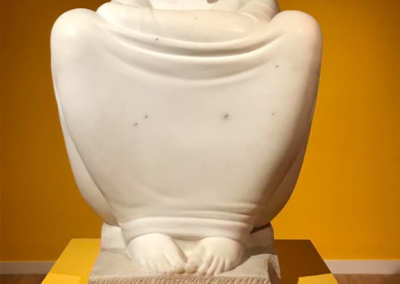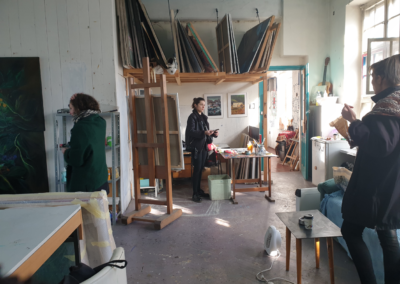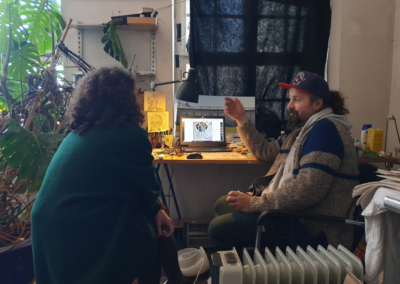
The first resident of the AFAR project is Sarah McNulty, (b. USA, based in Copenhagen) founded and curates the program Tørreloft, initiated in 2015, based on experimental forms of production, collaboration and experience for international artists. In opposition to the original clandestine drying attic, the current format at AGA Works takes place in an industrial garage, where the 4th wall is a shutter that opens to a busy street.
In her own practice as an artist she works primarily with expanded painting as a starting point, often as installations with textiles and other surfaces with shifting characteristics. Her work as both an artist and curator explores the ecology of the built environment, frequently initiating projects in overlooked architectural sites in the public sphere.
As part of the residency, Sarah McNulty, gets to know the Croatian art scene with the aim of international connections and inviting Croatian artists to Denmark, and the residency will include visits to studios and exhibitions.
February-March
Curatorial Fellowship
During my time in Zagreb, I was introduced to numerous artists, through studio visits, exhibitions, openings and talks. This included meeting a wide range of intergenerational practicing artists, from students at the fine arts academy to established practicing artists, in a variety of institutions around the city. I was met with an openness to discuss, share work and ideas, and many generous invitations to learn about a diverse selection of artistic practices.
I was struck by the engagement and audience for art in the city, exhibitions, talks and openings which were widely attended, by a variety of younger and older visitors. There were a surprising number of openings and cultural events throughout each week, both for students, emerging and more established artists, providing many options for audiences to engage in art in various formats and varied settings during the month-long residency. There appears to be a solid support and interest in the art scene, active and lively in the city. Various areas in the city are being utilized and activated, with active initiatives from both emerging artists and curators, as well as established art institutions.
I was impressed at the engagement of the artists, the initiatives of young and established curators creating spaces, events, residencies and other opportunities for artists, and the large-scale artist’s association of HDLU with an active program. There is an impressive structure with opportunities to support artists and public arts programs, socially engaged in innovative and ambitious programs. It was interesting to learn more and observe the benefits of such a large arts organization with so many artists participating in, particularly in comparison internationally, with cities I have lived and worked in, such as Copenhagen, London and New York. The Freelance artist association was also interesting as a support, from what I understand allows selected professional artists certain benefits, to dedicate more time to their practices. These structures influence the practices of artists in terms of the extent of supplemental income sources required.
I observed a diverse variety of media, style and approaches in the work I encountered, from painting, sculpture, performance, lens-based media and interdisciplinary work. There was a strong tradition of figurative and landscape painting, working often with clear narratives and references. Students at the academy and emerging artists were engaged, active and experimental and there seemed to be a strong sense of community and collaboration developing. Much of the artwork that I saw had cultural and political reference points in terms of the subject and perspectives. The unique location and challenges the country has faced, also in recent history which has personally impacted many, have powerful impact and give a resilience and strong voice. The environment, identity and history of the region appear to have a visible presence in the art and dialogue around it, embraced by artists and resonate in the artistic output.
The city of Zagreb itself was also very interesting to observe and learn more about, particularly the architecture and history of how it has evolved, as well as how artists work and exhibit in the context of the environment. I had a number of tours of the city and surrounding areas, encountering both the nature, built environment, and public artworks, in and around Zagreb. The impact of the earthquake is very visible, a number of buildings and institutions closed, still under repair. I noticed that beyond the Academy, there were not many larger scale studios for artists to work together, to collaborate in terms of ideas and practices, though it seems they socially maintain consistent dialogue and strong community. There were many very interesting, enormous buildings that were not inhabited, and I wonder how connections between owners and artists could be facilitated, for more studios or artist-run spaces, who could utilize them, in the short or long term. There were a couple interesting examples in various ways artists and curators have initiated space to work or create exhibition and event spaces, such as KUĆĆA, Karas, Medika, TOZ Pencil Factory, Garaza Kamba, and KVADAR. There appears to be an interesting potential to develop additional artistic artist-led communities, studios and spaces.
Artists expressed interest in international connections and an awareness of both the benefits and limitations of the scale of the city and art scene. Continuing to develop connections and exchanges, such as with the AFAR project, seem beneficial to progress and well prioritized. Continuing to connect with exhibition spaces abroad could open dialogue, in terms of alternative program formats, as well as architectural set-up, and to experiment with other approaches to spatial installations.
Overall, it was enormously enlightening and beneficial to have the opportunity to come to Zagreb and learn much more about the region and the art scene, which I had limited contact with previously. There were many active and innovative approaches to practices and presenting work, and great potential to develop this within larger international networks. I feel honored to have met so many engaged, open members of the artistic community, who were very gracious and curious. It has started so many connections and conversations which I hope to continue.
The AFAR Network project is co-funded by the European Union: ”Views and opionions expressed are however those of the autohor(s) only and do not necessarily reflect those of the European Union. Neither the European Union nor the granting authority can be held responsable for them.”

